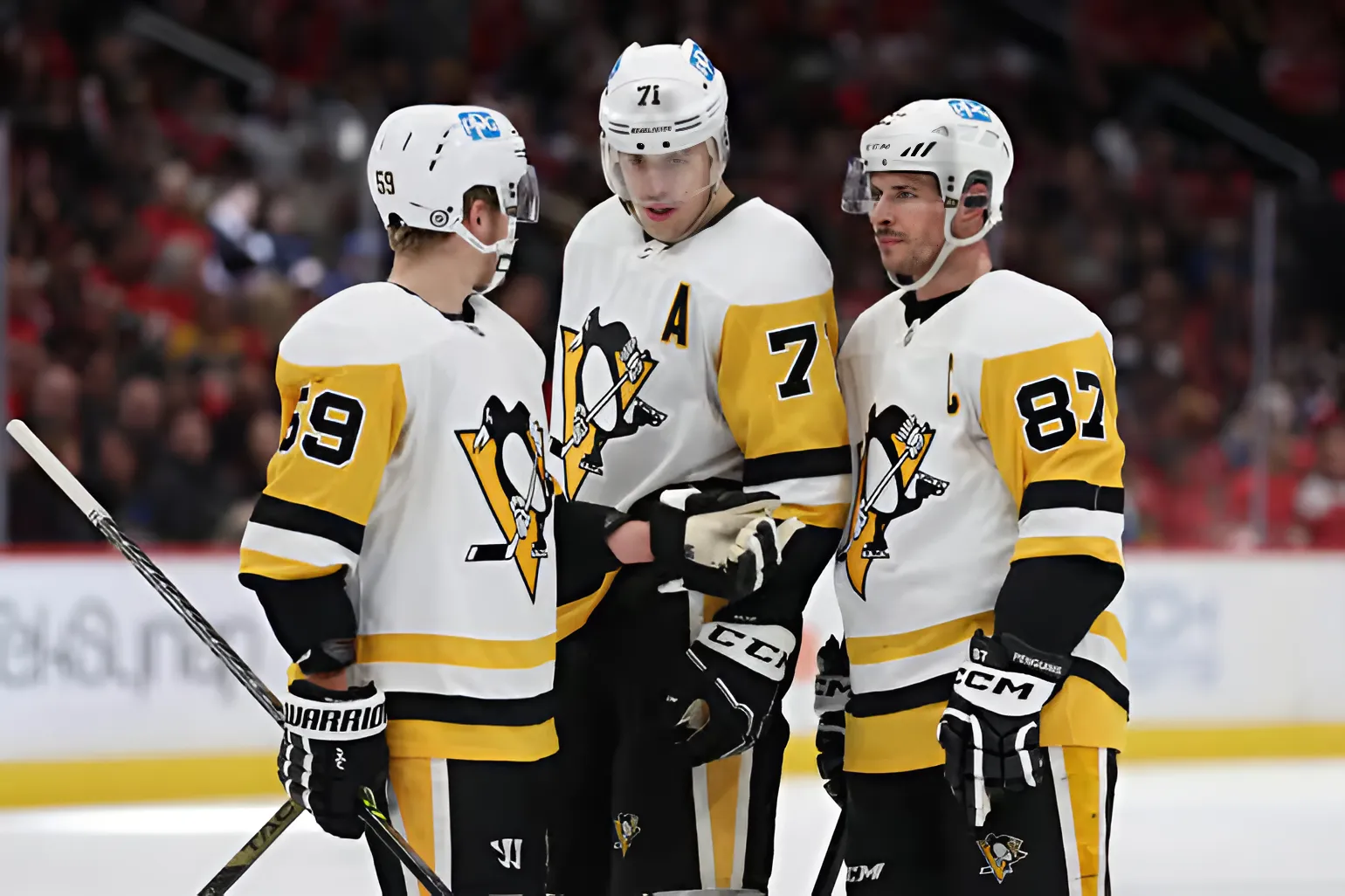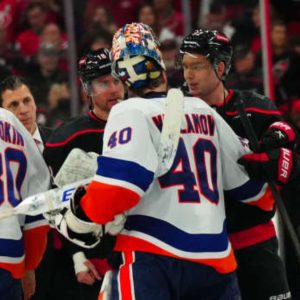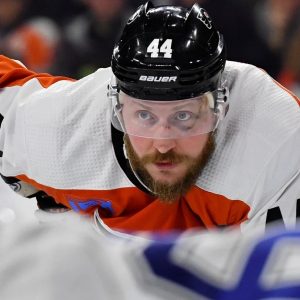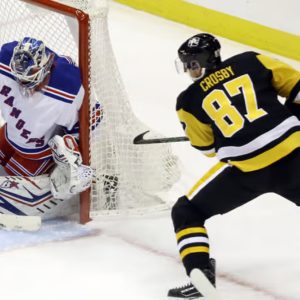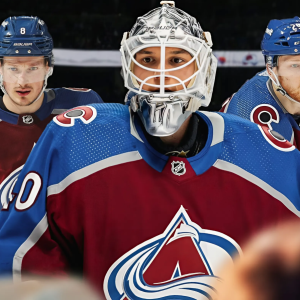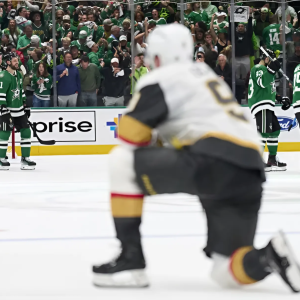After the first week of NHL free agency, where does your team stand?
If there’s still a gaping hole, there are only a few options left to fill it. Let the Daniel Sprong sweepstakes begin.
What’s each team’s biggest unaddressed need? The Athletic asked its NHL staff. Here’s what they said.
Anaheim Ducks
A right-shot top-four defenseman
Another top-six wing could be in this space, as well, given that neither need has been addressed. It’s why Steven Stamkos would have been ideal, and Jonathan Marchessault was a strong secondary target. But a right-handed defenseman was also on general manager Pat Verbeek’s shopping list, and Brian Dumoulin doesn’t fill that hole, even though he should help the defense overall. As of now, it’s likely that the Ducks will have to move one of their lefties over to the right side. Cam Fowler and Jackson LaCombe can do it, but both are stronger on their natural side. While Tristan Luneau has a lot of promise, Radko Gudas is their only proven right-shot defender. — Eric Stephens
Boston Bruins
A scoring wing
The Bruins do not have consistent scoring presence aside from David Pastrnak and Brad Marchand. They are worse off for letting Jake DeBrusk go. It’s hard to say whether Fabian Lysell, their 2021 first-rounder, can make an NHL breakthrough in camp as the No. 2 right wing. The Bruins do not have enough space to sign an impact wing. They will have to produce offense elsewhere. — Fluto Shinzawa
Buffalo Sabres
A top-six forward
Unless Jason Zucker is going to play on the top two lines, the Sabres didn’t add to the top six. They also bought out Jeff Skinner, so a team that regressed offensively last season lost one of its best five-on-five point producers. The Sabres are betting on improvement from players like Tage Thompson, Dylan Cozens, Alex Tuch and Jack Quinn to get their scoring back to 2022-23 levels. Trading for Ryan McLeod solved Buffalo’s need for a third-line center. But there’s still room to add to the top six, and the Sabres have the cap space to make a deal if one is available. — Matthew Fairburn
Calgary Flames
A center
The Flames’ center depth could still use some work, but they’ll likely look to address that issue internally. Nazem Kadri, Mikael Backlund, Yegor Sharangovich, Martin Pospisil, Connor Zary and Kevin Rooney are all possible/likely centers. Sharangovich, Pospisl and Zary, however, could easily be wingers out of necessity. The Flames aren’t above acquiring a young center who could be part of their future for years to come. The deal just has to make sense. — Julian McKenzie
Carolina Hurricanes
A top-six forward (or two)
After losing Jake Guentzel and Teuvo Teravainen, the Hurricanes could use at least one more winger to round out their top six. Questions also continue to swirl around Martin Necas, who is a restricted free agent and has expressed that he would like to move on. Carolina continues to shop him, but losing Necas would create another hole up front. Perhaps the Hurricanes can swing a trade that nets them multiple NHL forwards — maybe even a second-line center? — to fill out a group that looks a little thin. — Cory Lavalette
Chicago Blackhawks
Elite wingers
The Blackhawks definitely improved their offensive upside with Tyler Bertuzzi and Teuvo Tervainen, but neither is quite in the “elite” category. The same would go for Taylor Hall and Andreas Athanasiou, among others. The Blackhawks are hoping as a group that they can score more and can also help elevate Connor Bedard to new heights. General manager Kyle Davidson isn’t expected to add anyone else this summer. — Scott Powers
Colorado Avalanche
Secondary scoring (maybe?)
This is a really tough question to answer without knowing what the future holds for captain Gabriel Landeskog and forward Valeri Nichushkin. If neither of them are available in 2024-25, the Avalanche have a significant hole in their secondary scoring. If one or both play (and perform to their expectations) then that suddenly isn’t much of a concern. At that point, the weakest point of the team is likely the goaltending, where general manager Chris MacFarland is standing pat with Alexandar Georgiev and Justus Annunen so far. — Jesse Granger
Columbus Blue Jackets
A new home for Patrik Laine
The Blue Jackets and Patrik Laine have decided to end their relationship, but that isn’t likely to happen until Laine is cleared from the NHL/NHLPA’s players’ assistance program. Other NHL teams want to speak with Laine before trade talks can advance, Blue Jackets general manager Don Waddell said. But with the NHL Draft having passed and free agency well underway, the music is about to slow to a crawl for the offseason, making it more difficult for Laine to be traded. Waddell is expected to name a new coach any day, but the need to trade Laine looms over the offseason. They may have to tolerate each other into next season if a deal can’t be found. — Aaron Portzline
Dallas Stars
A top-four defenseman
The Stars are set up nicely on depth defensemen, with plenty of players who profile as solid third-pairing options. Miro Heiskanen and Thomas Harley are bona-fide top-four players, and Esa Lindell can play there as well. But unless Matt Dumba or Ilya Lyubushkin experience a resurgence — or Lian Bichsel is NHL-ready very soon — Chris Tanev’s departure leaves a void in the top four. — Saad Yousuf

Esa Lindell and Miro Heiskanen could use help on defense. (Codie McLachlan / Getty Images)
Detroit Red Wings
A right-shot top-four defenseman
Detroit added power-play quarterback Erik Gustafsson to replace Shayne Gostisbehere and indicated it will try him on the right side, but he’s more of an offensively tilted player who’s best cast on the third pair. That likely means the Red Wings will once again turn to Jeff Petry in the top four behind Moritz Seider. There was some hope Detroit could find someone to help take a little pressure off Seider, who played the toughest minutes in the NHL last season, but with limited cap space (once accounting for Seider and Lucas Raymond extensions), it looks like this is the group the Red Wings will take into the season. — Max Bultman
Edmonton Oilers
Help on the right side of the defense
Bringing in Josh Brown to replace Vincent Desharnais, who left for Vancouver in free agency, arguably makes the Oilers even weaker at their weakest position. At least lefty Philip Broberg, now an RFA, stepped up in that regard for the last two rounds of the playoffs and is seen as an option there. This promises to be something that’s addressed before the 2025 trade deadline. — Daniel Nugent-Bowman
Florida Panthers
A fourth line
With guys like Ryan Lomberg, Nick Cousins and Kevin Stenlund headed elsewhere, the Panthers will have a decidedly different mix on the fourth line, whether they make another low-cost addition or not. General manager Bill Zito has shown a knack for finding cost-effective options at the bottom of his lineup, though. It wouldn’t be a surprise to see them bring in an interesting PTO candidate or two as camp gets closer. — Sean Gentille
Los Angeles Kings
Top-nine scoring up front
Early in 2023-24, the Kings got scoring from throughout their lineup and were among the league leaders in goals. As the season went, the goals became harder to come by and the absence of an often-injured Viktor Arvidsson, along with the struggles of Pierre-Luc Dubois, became much more noticeable. They’ve moved on from both, but their summer acquisitions have yet to provide a boost for an offense that finished 17th in 2023-24. There isn’t much left on the market. Tyler Johnson, Daniel Sprong and James van Riemsdyk are available, but are any of them better fits than what they have as down-in-the-lineup contributors? — Eric Stephens
Minnesota Wild
A second-line winger
The Wild only had $4 million or so to spend in free agency and didn’t want to go long-term on a top-six winger, so it was always going to be difficult. But they opted to allocate their funds to another third-liner in Yakov Trenin. The Wild finished 21st in the NHL with 3.02 goals allowed per game last season, so somebody new to take scoring pressure off Kirill Kaprizov, Matt Boldy and Joel Eriksson Ek would have been welcomed. Maybe they can figure out a way to trade some money and make a trade later in the offseason, but that’ll be difficult. So for now, they’ll be looking for internal improvement from Ryan Hartman, Marcus Johansson and Freddy Gaudreau. — Michael Russo
Montreal Canadiens
To trade a defenseman
The Canadiens have a surplus of young, cheap and NHL-ready defensemen and waiver eligibility will make it a complicated group to manage very soon. Along with the boatload of draft capital they have next year, they would like to turn one or two of those defensemen plus one or two of those picks into some help at forward, preferably someone young who fits into the core group they are currently forming. — Arpon Basu
Nashville Predators
Center depth
The Preds still aren’t where they want to be down the middle, though Steven Stamkos certainly could end up centering a line — how about Filip Forsberg and Jonathan Marchessault with him while Ryan O’Reilly works with Gus Nyquist and rising forward Luke Evangelista? The possibilities are exciting, and Tommy Novak could figure into a top-two center role. Still, you’d like to see another answer at center, and that won’t arrive before the season does. — Joe Rexrode

Will Steven Stamkos see significant time at center in 2024-25? (Lawrence Scott / Getty Images)
New Jersey Devils
A Tyler Toffoli replacement
The Devils could’ve used a goal scorer like Toffoli, whom they traded away last trade deadline. The Tomas Tatar signing should help fill that void to some extent if he can rebound to his form from 2022-23, when he was with the Devils. He had 20 goals and 48 points that year, then had a difficult season with Colorado and Seattle. The Devils probably won’t have cap space to work with after signing Dawson Mercer’s restricted-free-agent deal, but they can try to upgrade during the season if needed. — Peter Baugh
New York Islanders
More top-nine impact
This can only happen if there’s a salary-cap dump in the works. J-G Pageau makes the most sense to move out, but only Lou Lamoriello knows if that’s what this team is going to do. If Pageau is moved, then there’s a chance to add, but trades are obviously the only way to bring in skill this late into free agency. — Arthur Staple
New York Rangers
A guarantee at top-line right wing
The Rangers’ biggest need entering the summer was to find someone to play with Mika Zibanejad and Chris Kreider. Reilly Smith might be the answer, but it’s not a guarantee. New York probably won’t be able to add another big piece this summer unless it pulls off a trade involving roster players. The Rangers also could use another defenseman, though it makes sense to give Zac Jones a chance to be an everyday player, at least at the start of the season. — Peter Baugh
Ottawa Senators
A third pairing on defense
The Senators finally seem to have sorted out their top four by trading Jakob Chychrun for Nick Jensen. But there are now some question marks on their third pairing, with Erik Brannstrom no longer part of the equation. As it stands, the third pairing may consist of a couple of young defensemen in Tyler Kleven and Jacob Bernard-Docker. Veteran Travis Hamonic is part of the mix, too. If general manager Steve Staios is going to make any more moves this summer, something to add a bit of veteran help or experience on his third pairing might be the play. — Ian Mendes
Philadelphia Flyers
Elite skill
The Flyers’ biggest challenge from now until 2026-27 — probably the earliest they expect to truly compete again — will be finding elite-level players to lead the way. Perhaps Matvei Michkov will be one of them now that he’s here, but a true No. 1 center remains their biggest need. That could come in the form of a hockey trade, particularly as the Flyers have three first-round and three second-round picks in the 2025 draft. For now, though, the front office has remained dormant, still waiting for what it views as the correct deal for the future. — Kevin Kurz
Pittsburgh Penguins
A winger for Sidney Crosby
General manager Kyle Dubas needs to tie up a couple of loose ends. Both are big and involve captain Sidney Crosby. And while it’s presumed one of those loose ends — inking Crosby to a contract extension — will happen, every day that it doesn’t makes the issue hover like a storm cloud. Still, it’ll probably get done. When it does, or before, Dubas also needs to find a replacement for Jake Guentzel as Crosby’s primary scoring option on the wing. Right now, the usually-top-heavy-at-forwards Penguins are a proven winger short of a viable top six — and the hole is on Crosby’s top line. — Rob Rossi
San Jose Sharks
A power-play quarterback
The Sharks picked up Jake Walman as a blueliner with a big shot who can slide to the left side of their defense, but they still don’t have a true puck-mover to run their first power-play unit. At times, they use five forwards for the man advantage because they had no one to fill Erik Karlsson’s old role and the now-departed Calen Addison didn’t exactly distinguish himself. Tyson Barrie could be a candidate here, as he’d check off a couple of boxes in being a proven power-play quarterback and a right shot to boot. Barrie could also be flipped at the trade deadline if he gets minutes and produces. — Eric Stephens
Seattle Kraken
Elite talent
The Kraken’s biggest unaddressed need remains a big-picture one as opposed to a specific team-construction one: elite talent. From the outset, the Kraken have been built well, with serious depth and speed and structural know-how. Despite Vince Dunn’s emergence as a top-pair driver and Matty Beniers’ continued promise (despite his sophomore struggles), the Kraken’s core of elite talent is still very much under construction. That’s likely to make life difficult over the long haul. A high-end core can cover any manner of roster-construction sins, but the Kraken appear to be locked into being too good to have first dibs on the best players in the draft and not good enough to contend meaningfully. Selecting Berkly Catton — a pure upside pick at No. 8 — shows that the Kraken understand the task at hand, but their structural position still puts them at a disadvantage in trying to level up organizationally. — Thomas Drance
St. Louis Blues
To trade a defenseman
The best way for Blues general manager Doug Armstrong to alter his roster this summer is to make changes on defense. The right side is set with Colton Parayko, Justin Faulk and Matthew Kessel, so the left side is likely where change would come. But in order to make any moves, they would need Torey Krug to waive his full no-trade clause. Until that happens, it’s difficult to even enter the market for a replacement. Former Blues defenseman Joel Edmundson would’ve made some sense, but not at the cost L.A. paid him with a four-year, $15.4 million deal ($3.85 million average annual value). — Jeremy Rutherford

Torey Krug went minus-31 in 2023-24. (Tim Nwachukwu / Getty Images)
Tampa Bay Lightning
Depth
Technically, the Lightning have 12 signed forwards at the NHL level. Once restricted free agent J.J. Moser extends, they will have six defensemen, too. If Emil Lilleberg is expected to be an NHL regular next season, then there’s a mix of seven to rotate. Still, it wouldn’t hurt to bring in a little more help. A good focus would be on a secondary scorer so the Lightning’s approach isn’t too top heavy. Cam Atkinson could be a fine addition in that regard, but one more third-line caliber forward should be on management’s radar. — Shayna Goldman
Toronto Maple Leafs
A top-nine center
The Leafs got nothing out of their third- and fourth-line centers — Pontus Holmberg and David Kämpf — in the playoffs and haven’t upgraded the position at all this summer. Max Domi was re-signed in part because of his ability to play center and could slide back into the middle next season. He played his best last season on Auston Matthews’ right wing, though, and wasn’t their first, second or third option to play center before that. The Leafs also figure to have John Tavares remaining at center at age 34 and entering his 16th NHL season. There’s nothing left in free agency, so barring a trade, this is what the Leafs have for now. — Jonas Siegel
Utah HC
An elite forward
Most of general manager Bill Armstrong’s work before and through the early weeks of free agency focused on strengthening the defense corps — and he did that by adding Mikhail Sergachev and John Marino in trades and Ian Cole in free agency. Utah stood pat in goal and so for now will deploy a rotation again, featuring Connor Ingram and Karel Vejmelka. But if they want to compete with the elite teams in the Central, they likely need to add another impact scoring forward. After Clayton Keller’s 33 goals, the next highest total was the 23 that they got from Lawson Crouse. They have the cap room (about $15 million) to accommodate one more big salary if someone like a Mitch Marner is available. — Eric Duhatschek
Vancouver Canucks
Another No. 3 defenseman
The Canucks made do on the back end last season with an elite top pair and two pairings that probably graded out as “very good third pairs.” With Ian Cole and Nikita Zadorov heading elsewhere in free agency and the club plugging in Vincent Desharnais and Derek Forbort to replace them, the third pair now grades out as a more conventional, average third pair. Ideally, if the club was able to identify and acquire a credible No. 2 or No. 3 defender, it could bump either Carson Soucy or Tyler Myers down to the third pair to strengthen that group and have a stronger blue line on paper. — Thomas Drance
Vegas Golden Knights
A top-six winger
The Golden Knights lost 94 goals to free agency or trade this offseason, or 35.7 percent of their total from 2023-24. The additions (Alexander Holtz and Victor Olofsson) have offensive upside, but they’re also coming off a season in which they combined for only 23 goals. Considering Mark Stone’s injury history and the fact that Ivan Barbashev isn’t a pure scorer, Vegas will be relying heavily on its centers for offense this season. — Jesse Granger
Washington Capitals
Another winger
Andrew Mangiapane alone doesn’t address all of the Caps’ issues outside, especially if T.J. Oshie lands on long-term injured reserve. They just don’t have enough contender-quality contributors, though Connor McMichael and Alexei Protas still have room to grow, and they don’t have the cap space necessary to make any more meaningful additions without major salary heading back out. — Sean Gentille
Winnipeg Jets
A contingency plan
I expect Kevin Cheveldayoff and company have contingency plans ready: They missed on Sean Monahan, for example, so they went after Adam Henrique. I think they traded for Monahan in the first place because they missed on Elias Lindholm. They’re good at moving from Plan A to B to C as necessary. At a certain point, however, it becomes time to look at roster holes at second-line center and top-four defense and explore the idea that the answers could be inside the organization. There are unique cap advantages available if Cole Perfetti and Dylan Samberg can take big steps forward, with tremendous long-term payoffs if they hit and cap space to use at the deadline if they don’t.
